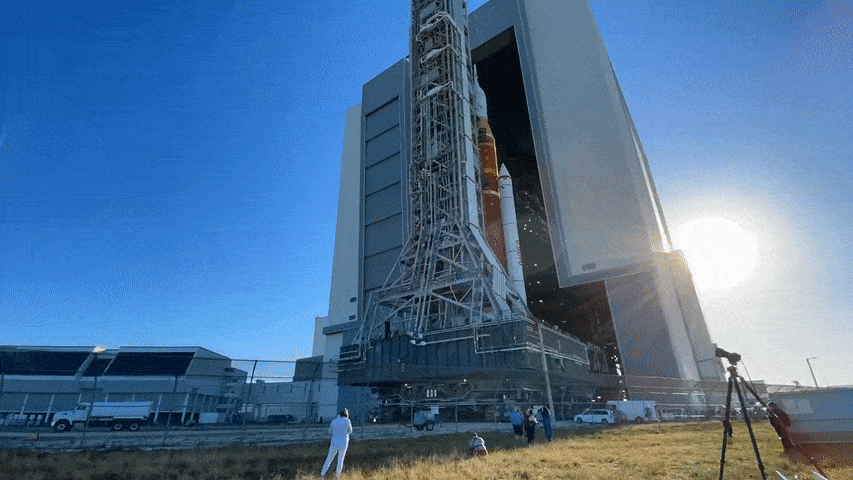NASA announces third launch attempt date for its 'mega moon rocket'
The space agency says the rocket's technical problems have been fixed

NASA’s "mega moon rocket" is now scheduled to make its third liftoff attempt on Sept. 27, the US space agency has announced.
The Artemis 1 rocket is made up of the six-person Orion capsule perched atop the 30-story Space Launch System (SLS) — dubbed the "mega moon rocket" — and was initially scheduled to embark on its maiden voyage to the moon and back on Aug. 29.
But technical difficulties foiled the rocket’s first two attempts at liftoff. NASA scrubbed the rocket's first attempt because engineers were unable to cool one of the rocket's four core stage RS-25 engines down to a safe temperature in time for liftoff. The agency announced that it had fixed the problem, which it blamed on a faulty temperature sensor. Then, during the rocket’s second attempt, an alarm sounded as the craft was being loaded with its supercooled liquid hydrogen fuel, alerting engineers to a gap in the seal of one of the rocket's engines. Engineers tried and failed to plug the leak three times, NASA said.
Related: Lightning strikes Artemis I mission's 'Mega Moon rocket' launch pad during tests
NASA said that the leak was at a "quick disconnect" where the SLS core stage met the fuel line from the rocket's mobile launch tower, which the agency fixed by replacing two seals at the leak point. The U.S. space agency says the earliest launch opportunity will be Sept. 27, with a backup opportunity on Oct. 2. NASA engineers plan to demonstrate the leak is patched by conducting a test to pump propellant into the craft on Sept. 17.
"The updated dates represent careful consideration of multiple logistical topics, including the additional value of having more time to prepare for the cryogenic demonstration test, and subsequently more time to prepare for the launch," NASA officials wrote in a blog post announcing the new launch date. "The dates also allow managers to ensure teams have enough rest and to replenish supplies of cryogenic propellants."
Orion is planned to make two fly-bys of the moon 62 miles (100 kilometers) above the lunar surface, zipping as far out as 40,000 miles (64,000 km) beyond the moon before returning to Earth 38 days after launch.
Sign up for the Live Science daily newsletter now
Get the world’s most fascinating discoveries delivered straight to your inbox.
NASA has stowed three mannequins aboard the capsule that will be used to test radiation and heat levels during the flight. A Snoopy soft toy is also along for the ride, floating around inside the capsule as a zero-gravity indicator.
When Orion comes back, it is set to return hotter and faster than any space vehicle ever has, heating up to 5,000 degrees Fahrenheit (2,800 degrees Celsius) as it enters Earth's atmosphere at 32 times the speed of sound. This will put the capsule's ablative heat shield to the test, which, alongside the craft's parachute, will use air friction to slow Orion down to just 20 mph (32.2 km/h), after which it should plop down safely in the Pacific Ocean off the coast of Baja California, Mexico, ready for retrieval.
The flight will be followed by Artemis 2 and Artemis 3 in 2024 and 2025/2026 respectively. Artemis 2 will make the same journey as Artemis 1, but with a four-person human crew, and Artemis 3 will send the first woman and the first person of color to land on the moon's south pole.
Speaking to BBC Radio 4 before the second launch attempt, NASA Administrator Bill Nelson said that the test mission will be a spur for technological innovation and a crucial next step in humanity's exploration of the cosmos.
"This time we're going not just to touchdown [on the Moon] and leave after a few hours or a few days — we're going back to learn, to live, to work, to explore, to determine is there water; therefore on the [moon's] south pole that would mean we have rocket fuel, we have a gas station up there," Nelson said. "This time we're going to learn how to live in that hostile environment for long periods of time, all with the purpose that we're going to Mars."
Originally published on Live Science.

Ben Turner is a U.K. based staff writer at Live Science. He covers physics and astronomy, among other topics like tech and climate change. He graduated from University College London with a degree in particle physics before training as a journalist. When he's not writing, Ben enjoys reading literature, playing the guitar and embarrassing himself with chess.
